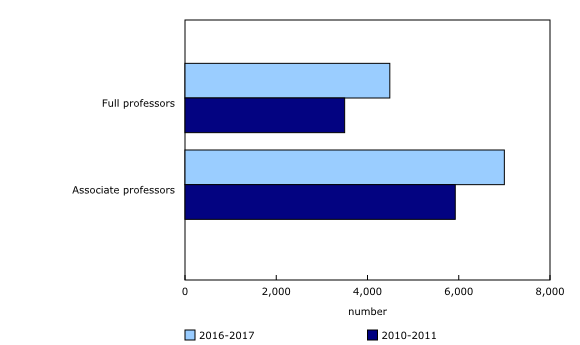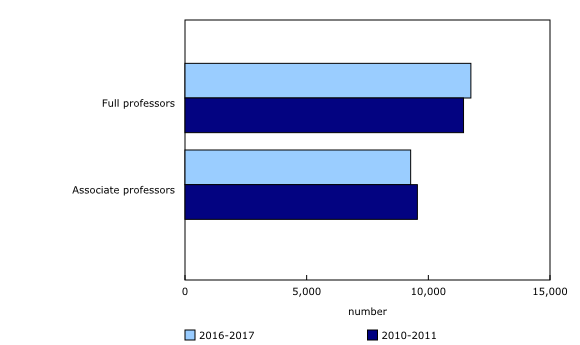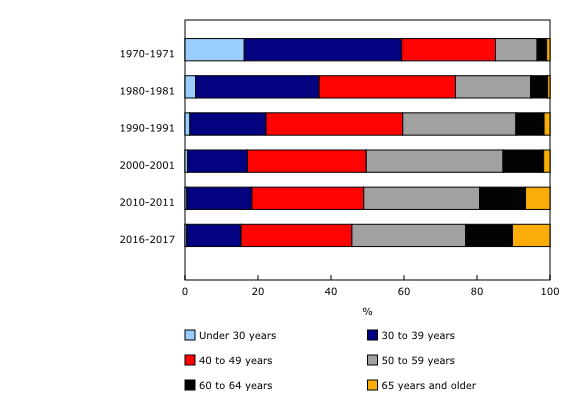Number and salaries of full-time teaching staff at Canadian universities, 2016-2017
Archived Content
Information identified as archived is provided for reference, research or recordkeeping purposes. It is not subject to the Government of Canada Web Standards and has not been altered or updated since it was archived. Please "contact us" to request a format other than those available.
Released: 2017-11-28
Women accounted for almost 40% of full-time academic teaching staff at Canadian universities in 2016-2017, up from 36.6% in 2010-2011. This is more than three times the proportion in 1970, when women comprised 12.8% of full-time teaching staff.
The data come from the Full-time - University and College Academic Staff System (FT-UCASS), which provides a detailed portrait of full-time academic staff in Canada. With a historical time series going back to 1937, the data shows how the university teaching environment is changing over time. The results help government, universities and other researchers to plan for the future needs of students and university academic teaching staff.
The overall number of full-time academic teaching staff has edged up by 1.6% since 2010-2011. At the same time, university enrolments in these institutions increased by 7.5% from 2010-2011 to 2014-2015 (the latest year for which data are available). The change in teaching staff numbers, however, was not evenly distributed across all appointment categories, with increases taking place among higher-ranked tenure staff (full and associate professors), while the numbers of entry level and non-tenured staff (assistant and rank below assistant professor) decreased.
From 2010-2011 to 2016-2017, the total number of full professors (+8.6%) and associate professors (+5.2%) increased. At the same time, the total number of assistant professors decreased by 15.9%, while the rank below assistant professor increased by 2.1%. Among the full and associate professor ranks, women made significant gains.
Women lead the increase of higher rank full-time academic teaching staff
Most of the gains by women since 2010-2011 were seen at the higher ranks of full professor (+28.3%) and associate professor (+18.2%). At the same time, the number of female assistant professors fell by 12.1 %, while the rank below assistant increased by 2.3%.
Growth in the number of men in the full professor rank was more modest, reflecting their overall decrease in numbers. While still in the majority, the number of men in this rank increased by 2.6%. The number of men in the associate professor rank, however, decreased by 2.9%. The number of male assistant professors also declined (-19.2%). The proportion of males in the rank below assistant professor increased by 1.9% since 2010.
Since 1970, the number and proportion of women full-time academic teaching staff has risen considerably in all ranks. In 2016-2017, women comprised 27.7% of full professors, 43.0% of associate professors and 48.5% of assistant professors. This is in contrast to 1970-1971, when women comprised 3.4% of full professors, 8.1% of associate professors and 13.8% of assistant professors.
Improving gender equity among academic teaching staff is an important consideration for universities for a number of reasons, including mirroring the increasing gender equity among students and in Canadian society.
University professors are aging
One key component to managing and planning staffing and workforce renewal in universities is to look at the age profile of existing staff. The movement of the baby boom generation through the workforce and the aging of the Canadian workforce is all reflected in the demographic changes in academic teaching staff. In 2016-2017, the median age of teaching staff was 51. The median age rose by formal rank: from 39 years of age for assistant professors, to 49 for associate professors, to a median age of 57 for full professors. By comparison, in 2016-2017, the median age of the Canadian full-time working population (aged 15 and older) was 42 years.
In 1970, the full-time academic teaching staff were considerably younger, with a median age of 37. This contrasts with a median age of the Canadian full-time working population (aged 15 and older) of 34 years in 1976 (the first year for which these data are available). This suggests that the academic teaching staff population has aged more over the ensuing almost half-century than the Canadian full-time working population. In comparison to data from the UCASS in 1970-1971, there has been a notable shift in the distribution of age of full-time academic teaching staff. From 1970-1971 to 2016-2017, the proportion of staff in the youngest age cohorts (under 40 years of age) declined from 59.4% to 15.4%. The proportion of staff in the oldest age cohorts (60 years and older), meanwhile, increased from 3.5% in 1970-1971 to 23.1% in 2016-2017.
Of particular note are those academic staff aged 65 and older. This group has been increasing since 2000-2001, reflecting Canada's aging population. With the end of provincial mandatory retirement legislation in the mid 2000s, the rate of increase in this age group accelerated, reaching 10.3% by 2016-2017.
Teaching staff median salary increases over five-year period
In 2016-2017, the median salary, in constant dollars, of full-time academic teaching staff was $129,195, up 6.6% from $121,147 in 2010-2011. This increase was influenced by the increasing proportion of full-time academic teaching staff in the upper ranks. In 2016-2017, the median salary for full professors was $160,161; associate professors, $126,413; assistant professors, $99,323; and $94,515 for the rank below assistant professor. In comparison, in 2010, the median salary in constant dollars was $152,310 for full professors, $119,992 for associates, $95,816 for assistants and $93,555 for the rank below assistant professor.
The male-female salary gap is relatively narrow across academic ranks. Factors that may influence such differences can include (among other things) discipline taught and years of experience.
Among full professors in 2016-2017, female academic teaching staff ($154,470) earned 95.3% of their male counterparts ($162,030). Female associate staff ($124,715) earned 97.7% that of males ($127,680), while female assistant academic teaching staff ($98,320) also earned 97.7% of males ($100,595). In the "Rank below Assistant" category, the median female salary ($92,565) was 96.4% that of males ($96,070).
The full-time academic teaching staff with the highest median salaries are those who are a full professor and are 65 years of age and older. This is true for both men and women: men in this age bracket earned a median salary of $172,560, while women in this category earned $166,990.
Note to readers
The University and College Academic Staff System (UCASS) provides a detailed portrait of full-time academic staff in Canada, including gender, age, principal subject taught, academic rank, salary and administrative stipends, and province or country of degrees earned.
Statistics Canada last released Full Time-UCASS for the 2010-2011 academic year and reinstated the survey in the fall of 2016.
This is a final release of data on full-time university academic teaching staff for the 2016-2017 academic year. It includes 112 public degree granting universities and colleges.
Of these institutions, 66 had more than 100 academic teaching staff and selected data from these respondents at the institution level are available in CANSIM table 477-0123.
Contact information
For more information, or to enquire about the concepts, methods or data quality of this release, contact us (toll-free 1-800-263-1136; 514-283-8300; STATCAN.infostats-infostats.STATCAN@canada.ca) or Media Relations (613-951-4636; STATCAN.mediahotline-ligneinfomedias.STATCAN@canada.ca).
- Date modified:




